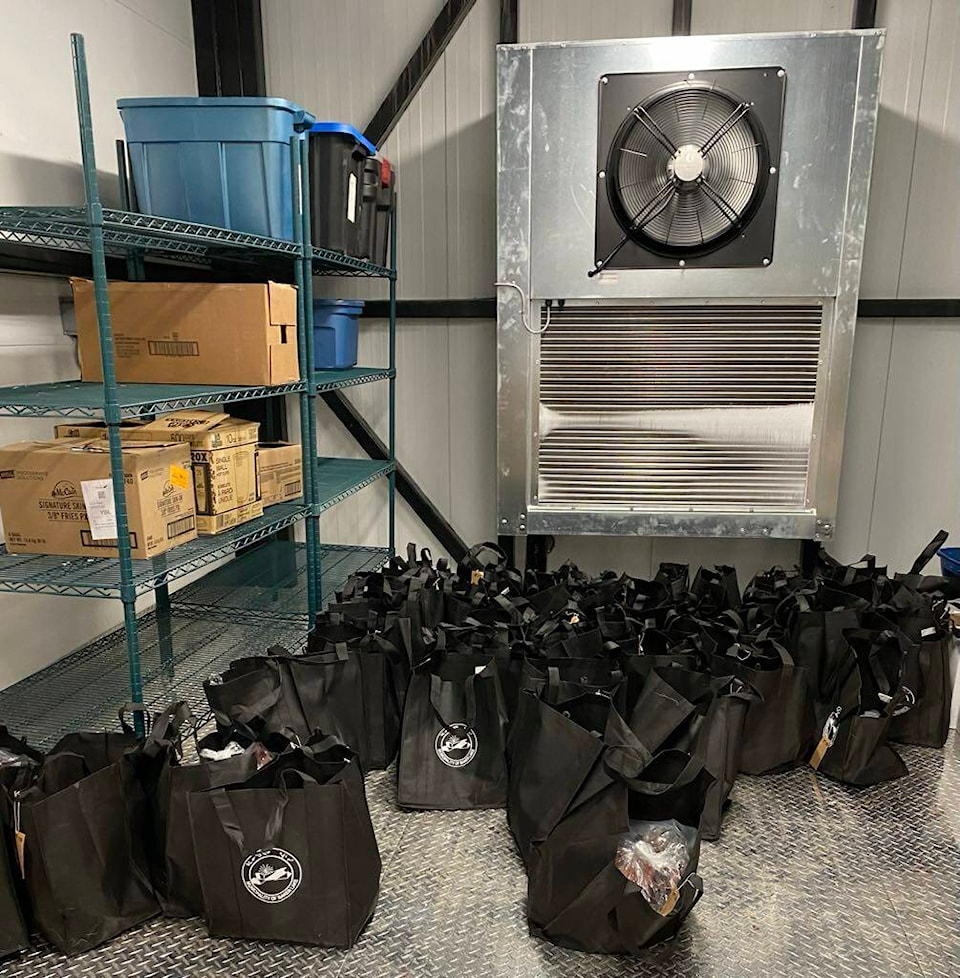For elders, caribou meat trumped blowing out candles when it came to celebrations marking Nunavut’s quarter-century anniversary in Baker Lake this past week.
Karen Yip, the hamlet’s community wellness co-ordinator, came up with the idea of delivering a package of caribou meat to every household in Baker with at least one elder, 60 years of age or older, living there.
Yip said she thought of the idea while pondering things she could do that would be both helpful and welcome for the elders.
The position calls on Yip to work a lot with elders, due to their importance to the community and the fact they don’t always get the attention they deserve.
There hasn’t been a lot of caribou sighted near Baker Lake during the past few months, so a little bit of caribou meat went a long way with many of the elders.
In an effort to exclude as few as possible, the hamlet included anyone set to turn 60 this year and ended up with a grand total of 116 households. For example, two people in a household both 60 and older got one package and one person 60 or older living alone also received one package.
With no hope of finding that many matching boxes in the North, Hamlet of Baker Lake bags, with freezer bags inside, were called into service and packed-up inside the community freezer.
Yip said the plan received positive feedback.
She said some elders have difficulty finding an opportunity to receive caribou meat and haven’t had any for awhile, so they were quite happy when their package arrived.
“One elder in particular was really happy that it was already cut-up in usable-sized pieces,” said Yip. “Usually, if you’re getting a caribou or half a caribou, you have to cut it up yourself. So, he was really pleased that it was in usable-sized pieces coming right out of the bag.
“That was kind of a bonus for them to find out. Some of the caribou was packaged meat and some of it was chunks cut-up into cooking-sized pieces.
“This was a special one-time thing we did while celebrating Nunavut’s 25th anniversary. It’s an expensive and time consuming project, so I don’t think we’ll be able to do it every year. It was a one-time bonus.”
At the time of the interview, the hamlet had only delivered about 25 per cent of the packages, so not too many responses had been received. Those that were, however, were incredibly positive.
Yip said she’s always happy working on projects such as this, but, when you receive positive responses, you feel even better about everything.
She said they had people thanking them, people being overjoyed receiving it, and everyone being just very grateful overall.
“Even when caribou are near, there are some people, for whatever reasons, don’t get as much as they would like. Some were great hunters in the past, but, circumstances have become quite different for them now, as they’ve reached the age where they can’t go hunting anymore.
“There’s widows and other lone people out there who are not always the first to be remembered. And some, unfortunately, will get forgotten and go without in silence.
“Most people in their 60s, or older, aren’t out there actively seeking caribou hundreds of miles away. So, all in all, people were very happy to get a little bit delivered to their homes.
“We’re just trying to help out, bring a little joy to people, fill some needs and try to give as many as we can a little piece of happiness.”
ᐃᓐᓇᑐᖃᕐᓄᑦ, ᑐᒃᑑᑉ ᓂᕿᖓ ᓇᑉᐸᖁᑎᓂ ᓱᐱᓂᖃᖅᑎᑦᑎᓚᐅᖅᐳᖅ ᖁᕕᐊᓱᖃᑎᒌᒃᑎᓪᓗᒋ ᓇᓗᓇᐃᖅᓯᔪ ᓄᓇᕗᑦ ᐊᕐᕌᒍᓄ 25 ᓇᓪᓕᕐᒪᑦ ᖃᒪᓂᑦᑐᐊᕐᒥ ᐱᓇᓱᐊᕈᓯᕆᓵᖅᑕᑦᑎᓐᓂ.
ᑭᐅᕋᓐ ᔨᑉ, hᐊᒻᒪᓚᒃᑯᑦ ᓄᓇᓕᖕᒥ ᐃᓄᓯᖃᑦᑎᐊᖅᑎᑦᑎᓇᓱᐊᖅᑎ, ᐃᓱᒪᓕᐅᕆᓚᐅᕐᒪᑦ ᑐᔪᐃᓂᖅ ᑐᒃᑑᑉ ᓂᕿᐊᓂ ᐊᖏᕋᖃᖅᑐᓕᒫᓄᑦ ᖃᒪᓂᑦᑐᐊᕐᒥ ᐃᓇᑐᖃᖃᖅᑐᑦ ᐊᑕᐅᓯᕐᒥᓪᓘᓃᑦ, 60−ᓂ ᐊᕐᕌᒍᖃᑐᐊᕈᓂ ᐅᕝᕙᓘᓃᑦ ᐅᖓᑖᓄ, ᖃᒪᓂᑦᑐᐊᕐᒥ.
ᔨᑉ ᐅᖃᖅᐳᖅ ᐃᓱᒪᒋᓚᐅᕐᒪᔾᔪᒃ ᐃᓱᒪᒋᔭᖅᓴᖅᓯᐅᖅᑎᓪᓗᒍ ᖃᓄᐃᓕᐅᕈᓐᓇᕐᒪᖔᕐᒥ ᐃᑲᔫᑎᖃᕈᓐᓇᕐᓗᓂ ᐊᒻᒪᓗ ᑐᖓᓱᒃᑎᑦᑎᔪᓐᓇᕐᓗᓂ ᐃᓐᓇᑐᖃᓂᒃ.
ᐃᖃᓇᐃᔮᓂ ᑕᐃᓯᔪᖅ ᔨᑉ−ᒥ ᐱᓕᕆᖃᑎᖃᕐᓗᓂ ᐃᓐᓇᕐᓂᒃ, ᐱᒻᒪᕆᐅᓂᖏᓐᓄ ᓄᓇᓕᖕᒧᑦ ᐊᒻᒪᓗ ᐃᓱᒪᒋᔭᐅᓗᐊᖅᐸᖏᑎᓪᓗᒋ ᐃᓱᒪᒋᔭᐅᔭᕆᐊᖃᕐᓂᖅᐹᖑᑎᓪᓗᒋ.
ᑐᒃᑐᓂ ᑕᑯᔪᖃᓗᐊᕌᓗᑲᑕᖏᑦᑐᖅ ᖃᒪᓂᑦᑐᐊᕐᒥ ᐊᑐᖅᑕᑦᑎᓐᓂ ᑕᖅᑭᐅᔪᑦ, ᐱᔾᔪᑕᐅᓪᓗᓂ ᓂᕿᑭᒃᑲᓗᐊᖅᖢᓂ ᑐᔪᐃᓚᐅᖅᑐᑦ ᐅᓄᖅᑐᓄ ᐃᓐᓇᑐᖃᕐᓄᑦ.
ᐃᓚᖑᖏᑎᑦᑎᑕᐃᓕᒪᓇᓱᒃᖢᑕ, hᐊᒻᒪᓚᒃᑯᑦ ᐃᓚᐅᑎᑦᑎᓚᐅᖅᑐᑦ ᐊᕐᕌᒍᑖᓕᒑᒃᐸᑕ 60-ᓂᒃ ᑕᒪᑐᒪᓂ ᐊᕐᕌᒍᑦᑎᓐᓂ ᑲᑎᓕᒫᖅᖢᒍ 116 ᐊᖏᕐᕋᓕᑦ. ᓲᕐᓗ, ᒪᕐᕈᒃ ᐃᓐᓇᐅᔪᑦ ᐊᖏᕐᕋᓕᒃ ᐊᑕᐅᓯᕐᒥᒃ ᑐᔪᖅᑕᐅᓪᓗᑎᒃ ᐊᒻᒪᓗ ᐃᓄᑑᒐᓗᐊᖅᐸᑦ 60−ᓂ ᐊᕐᕌᒍᖃᑐᐊᖅᐸᑦ ᐱᖃᑕᐅᓚᐅᖅᑐᖅ.
ᓇᓂᓯᔪᓐᓇᓚᐅᖏᓐᓇᑦᑕ ᕿᑐᑦᑐᖓᖑᔭᕐᓂᒃ ᐊᔾᔨᒌᒃᑐᓂᒃ ᐅᑭᐅᖅᑕᖅᑐᒥ, Hᐊᒻᒪᓚᒃᑯᑦ ᖃᒪᓂᑦᑐᐊᕐᒥ ᐴᒃᓴᐅᑎᑦ, ᐴᖅᖃᖅᑕᐅᓯᒪᑦᑎᐊᖅᑐᑦ, ᐱᔨᑦᑎᕋᖅᑕᐅᓪᓗᑎᒃ ᐴᖅᑲᖅᑕᐅᔪᑦ ᓄᓇᓕᑦ ᖁᐊᒃᑯᕕᐊᓂ.
ᐅᖃᖅᐳᖅ ᐃᓚᖏᑦ ᐃᓐᓇᑦ ᐊᔪᕈᑎᖃᖃᑦᑕᓚᐅᕐᒪᑕ ᑐᔪᖅᑕᐅᓂᖅ ᑐᒃᑑᑉ ᓂᕿᐊᓂᒃ ᐊᒻᒪᓗ ᓂᕆᓚᐅᖅᑲᒻᒥᖏᖦᖢᑎᒃ, ᖁᕕᐊᓱᓚᐅᖅᑐᑦ ᑐᔪᖅᑕᐅᑎᓪᓗᒋᑦ ᑐᒃᑑᑉ ᓂᕿᐊᓂᒃ.
“ᐊᑕᐅᓯᖅ ᐃᓐᓇᖅ ᐱᓗᐊᕕᒃᑐᒥ ᐱᒃᑯᓕᓚᐅᖅᑐᖅ ᓂᕿᑦ ᐊᒡᒍᖅᓯᒪᕙᒌᖅᑐᖅ ᑕᒧᐊᔭᐅᑐᐃᓐᓇᕈᓐᓇᖅᓯᓯᒪᔪᑦ”, ᐅᖃᖅᐳᖅ ᔨᑉ.
“ᐊᑐᕋᔪᒃᑲᓗᐊᕋᒥᒃ, ᓂᕿᒥᒃ ᑐᔪᖅᑕᐅᒍᕕᑦ ᐃᓗᐃᑦᑑᓗᓂ, ᓇᖕᒥᓂᖅ ᐊᒡᒍᕐᓗᒋᑦ. ᐱᔾᔪᑎᒋᓪᓗᒍ ᖁᕕᐊᒋᒻᒪᕆᓚᐅᖅᑕᓂ ᐊᒍᖅᓯᒪᕙᒌᕋᒥᒃ ᓂᕆᔪᓐᓇᑲᐅᑎᒋᓪᓗᓂᔾᔪᒃ ᐴᕐᒥᓂ.
“ᐱᒃᑯᓇᕈᑕᐅᑲᓐᓂᓚᐅᖅᑐᖅ. ᐃᓚᖏᑦ ᑐᒃᑑᑉ ᓂᕿᖏᑦ ᐃᓗᐃᑦᑐᑦ ᐃᓚᖏ ᐊᒡᒍᖅᓯᒪᔪᑦ ᓂᕿᓕᐅᕆᐊᖃᑐᐃᓐᓇᓕᖅᓯᒪᔪᑦ.
“ᑕᒪᓐᓇ ᐊᑐᓚᐅᑲᑐᐃᓐᓇᓚᐅᖅᑕᕗᑦ ᖁᕕᐊᓱᖃᑎᖃᕐᓂᖅ ᓄᓇᕗᑦ 25−ᓄ ᓇᓪᓕᐅᕐᓂᕐᕕᒃᓯᐅᕐᕕᐊ. ᐊᑭᑐᔪᖅ ᐊᒻᒪᓗ ᖃᐅᔨᓴᐅᒻᒥ ᐊᑐᖅᓱᖅᑐᖅ ᐱᓕᕆᐊᒃᓴᖅ, ᐊᕋᒍᑕᒫᖅ ᐊᑐᒍᓐᓇᔾᔮᖂᖏᑕᕗᑦ. ᐊᑕᐅᓯᐊᑐᐃᓐᓇᖅᖢᑕ ᐊᑐᖅᑕᕗᑦ.”
ᐊᐱᖅᓱᖅᑎᓪᓗᑕ, Hᐊᒻᒪᓚᒃᑯᑦ ᑐᔪᐃᓚᐅᖅᑐᑦ 25%−ᒥ ᓂᕿᓂ, ᑭᐅᔪᖃᓗᐊᓚᐅᖏᑦᑐᖅ. ᑭᓯᐊᓂ ᑭᐅᔪᑦ, ᐱᒃᑯᓇᖅᑐᒥ ᑐᓴᕐᓇᓚᐅᖅᑐᑦ.
ᔨᑉ ᐅᖃᖅᐳᖅ ᖁᕕᐊᒋᔭᖃᖅᐸᒃᑲᒥ ᐱᓕᕆᐊᓂ ᑕᐃᒪᓇ ᐱᓕᕆᔪᓂᒃ, ᑭᓯᐊᓂ, ᑐᓴᕌᖓᕕᒃ ᐱᐅᔪᓂᒃ, ᐃᖢᐊᕐᓂᖅᓴᐅᓐᓇᖅᐳᖅ.
ᐅᖃᖅᐳᖅ ᖁᔭᓕᓚᐅᓚᐅᖅᑐᑦ, ᖁᕕᐊᓱᒃᑐᑦ ᑐᔪᖅᑕᐅᒐᒥᒃ, ᐊᒻᒪᓗ ᑭᒃᑯᓕᒫᑦ ᖁᔭᓕᓂᖃᖅᖢᑎᒃ.
“ᑐᒃᑐᑦ ᖃᓂᑐᒦᑲᓗᐊᕋᖓᑕ, ᐃᓚᖏᑦ, ᐱᔾᔪᑎᖃᖅᖢᑎᒃ, ᑐᒃᑐᒐᓱᓗᐊᖅᐸᖏᑦᑐᑦ. ᐃᓚᖏᑦ ᑐᒃᑐᒐᓱᒃᑎᒻᒪᕆᐅᓚᐅᖅᓯᒪᔪᑦ, ᑭᓯᐊᓂ, ᐊᑐᖅᑕᓂ ᐊᓯᔾᔨᖅᐸᓪᓕᐊᒐᒥ. ᐃᓐᓇᐅᓕᖅᑳᑎᒋᖕᒪᑕ ᐊᖑᓇᓱᒋᐊᕈᓐᓇᐃᓕᔪᑦ.
“ᐃᓄᑑᔪᑦ ᐃᓱᒪᒋᔭᐅᖄᖅᐸᖏᒻᒪᑕ. ᐊᒻᒪᓗ ᐃᓚᖏᑦ, ᐊᐃᑦᑖᖑᒐᓗᐊᖅ, ᐳᐃᒍᖅᑕᐅᕙᒃᑐᑦ ᐅᖃᐅᓯᐅᖏᖦᖢᑎᒡᓗ.
“ᐃᓚᖏᑦ ᐊᕐᕌᒍᓕᑦ 60-ᓂᒃ, ᐅᕝᕙᓘᓃᑦ ᖑᖓᑖᓄ, ᐊᓂᓗᐊᖅᐸᖏᒻᒪᑕ ᕿᓂᕆᐊᕐᓗᑎᒃ ᑐᒃᑐᓂ ᐅᖓᓯᓗᐊᖅᑐᑦ 100 ᒪᐃᔪᔅᓂ.
ᐱᔾᔪᑕᐅᓪᓗᓂ, ᑕᒪᒃᑭ, ᐱᒃᑯᒍᓱᓚᐅᖅᑐᑦ ᑐᔪᖅᑕᐅᒐᒥᒃ ᐊᖏᕋᒥᓄ.
“ᐃᑲᔪᕋᓱᑐᐃᓐᓇᖅᑐᒍ, ᖁᕕᐊᓇᕐᓂᕐᒥᒃ ᑐᓂᓯᓗᑕ, ᐱᔪᒪᔭᓂ ᐊᑐᖅᑎᓪᓗᑎᒍ ᑐᓂᓯᓗᑕ ᖁᕕᐊᓱᖕᓂᕐᒥᒃ.”
